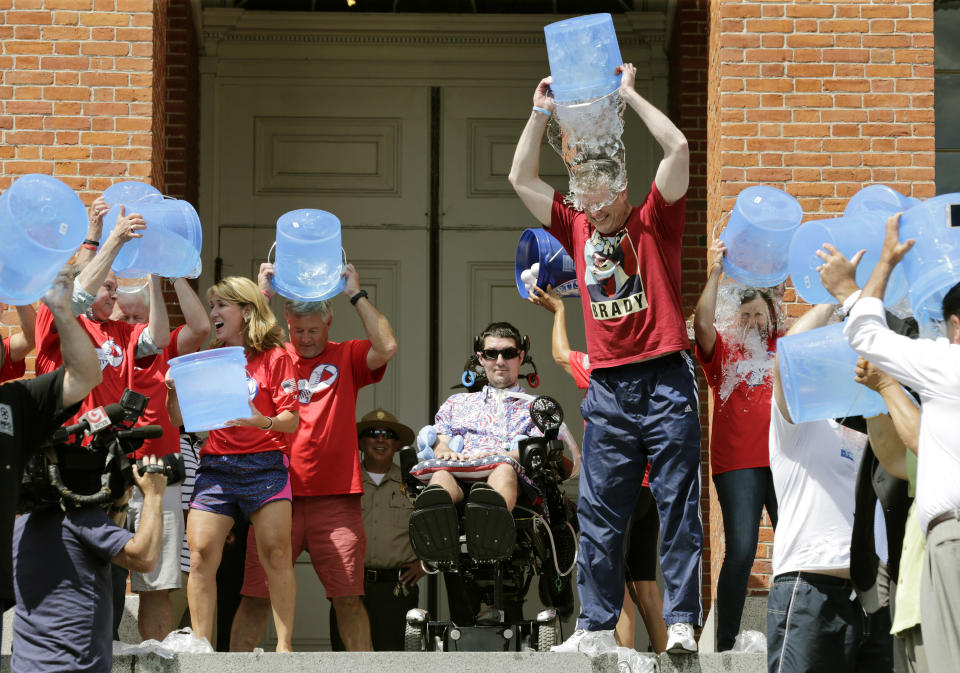The towering legacy of Pete Frates

When former BC baseball star Pete Frates was diagnosed with ALS in March of 2012, he sat down with his family and delivered precocious perspective amid the most harrowing news.
There’s no cure for ALS (Amyotrophic Lateral Sclerosis), which is also known as Lou Gehrig’s disease, as it attacks nerve cells and robs the body of movement. There are also no known survivors.
But that day, Frates told his family that he was going to fight to heighten awareness, build community and raise money to help families in the future. Frates essentially knew it was unlikely he was going to win his fight with ALS, but he spent seven years redefining the battle against it and will ultimately help future generations.
“Pete knew that his fight wasn’t about him,” BC baseball coach Mike Gambino told Yahoo Sports. “It was about the ALS community, so families in the future don’t have to go through what they went through.”
Pete Frates, 34, died on Monday after a heroic battle with ALS.
Nationally, he’s known as the force behind the 2014 Ice Bucket Challenge, which raised unprecedented funds and awareness to fight ALS. That movement helped raise hundreds of millions for ALS research and redefined modern fundraising through the use of social media.
During his seven-year battle, Frates became an icon of altruism in the city of Boston, one of this generation’s most noted sports heroes. A typical ALS diagnosis gives about 1,000 days to live, and Frates more than doubled that. In those seven years, he married his wife, Julie, became a dad to Lucy and crafted a legacy that will reverberate for decades. He rallied local sports franchises and athletes, leveraging the power of his own network to usher ALS awareness into the mainstream.

He popped up around town to support Boston’s sports teams, was a fixture at Boston College athletics events and took a deeply personal battle public. Along the way, the Frate Train charity became an indelible part of the city, with a Polar Plunge, bar nights and countless ways to, as the charity would say, #StrikeOutALS.
“While battling one of the world’s darkest diseases, Pete taught us how undaunted optimism can lay the groundwork to inspire a revolutionary movement,” Red Sox chairman Tom Werner said in a statement. “He did more to raise awareness for ALS during his lifetime than anyone in the past eighty years since Lou Gehrig delivered his ‘Luckiest Man’ speech.”
Frates, in many ways, became the most famous face of ALS since Gehrig himself died in 1941. By exposing his own vulnerability both in public and on social media, a generation followed Frates’ battle and came to better understand the viciousness of ALS. “Obviously ALS is undefeated,” Gambino said. “Pete took it 12 rounds, that’s for sure. He did everything he could.”
There was no better example than in 2014, when Frates’ network helped the Ice Bucket Challenge go viral. Everyone from Justin Timberlake to Conan O’Brien to Martha Stewart dumped a bucket of ice water on their head to help raise awareness and funds for ALS. Barack Obama donated, German Chancellor Angela Merkel dumped water over her head, along with Taylor Swift, Selena Gomez and Justin Bieber.
Estimates from that time revealed that nearly $200 million was raised. Not only did the Ice Bucket Challenge help fund research, it also raised an unprecedented level of awareness nearly eight decades after Gehrig’s death.
“He saw [his diagnosis] as an opportunity to give hope to other patients and their families,” the Frates family said in a statement released by Boston College. “In his lifetime, he was determined to change the trajectory of a disease that had no treatment or cure. … He was a beacon of hope for all.”
Consider the breadth of his recognition after his diagnosis. He was nominated, along with fellow ALS warrior Pat Quinn, for Time magazine’s “Person of the Year.” He received Sports Illustrated’s Inspiration of the Year honor in 2014 and has had both the field at his high school (St. John’s Prep) and the new baseball facility at Boston College named after him.
Over the years, the Frates family became fond of a saying that ALS is Lou Gehrig’s disease and, someday, Pete Frates’ cure. That day hasn’t arrived yet. But that bold direction Pete Frates took upon his diagnosis has redefined the way that ALS is viewed, researched and funded.
“It became a disease that now we have a chance to find a cure,” Gambino said. “The cure for ALS is coming. That’s a fact.”
The cure for ALS is closer thanks to Pete Frates and a promise he made to his family seven years ago. That’s a towering legacy of selflessness that will long linger in Boston and beyond.
More from Yahoo Sports:

 Yahoo Sports
Yahoo Sports